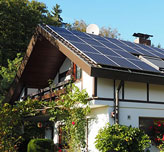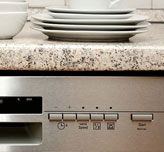HVAC > PASSIVE SOLAR

Passive Solar Heating & Cooling
Passive solar heating and cooling are energy efficiency strategies that utilize the sun's heat to heat or cool the home. Passive solar is free and smart, and through intelligent passive solar design a lot of your heating and cooling electricity bills can be reduced significantly.
Sun's energy can be used to heat the space through the right orientation of the windows, use of thermal mass, and cool the space through evaporative cooling.
Thermal Mass
Building materials such as concrete, bricks, tiles have a higher thermal mass, which allows them to absorb and store the heat from the sun for a longer time before discharging it into the interior space. In areas with large temperature swings during the day (warm days and cool nights) a higher thermal mass material in the wall or the floor will absorb the heat from the sun in the hot afternoon, and release it into the interiors or to the outside only after a gap of a few hours (in the evening when its cold), thus saving on both the AC in the afternoon and the furnace bill in the evening.
Using the sun's energy for heating and cooling your home is thus a smart, free strategy for tackling the cooling and heating loads.
Passive Heating strategies include increasing the number or the size of the windows in the south, and installing higher solar gain (SHGC) windows in cold climate. Also darker colored building envelope in cold climates can ensure more solar heat absorption through the envelope and reduction in heating loads.
Window Design, Thermal Mass, Window Shading, Evaporative Cooling, Reflective Envelope & Ventilation are some of the Passive Solar Design Strategies
Passive Cooling can be achieved by enabling evaporative cooling, and by minimizing the impact of the sun through intelligent window design (smaller windows on the west and south) and through the use of window overhangs and shading (cuts the solar gain in summers and allows solar gain in winters).
Intelligent use of thermal mass can be used to delay the heat absorption within the interiors. When the temperature falls at night, the thermal mass can be cooled using natural ventilation, through operable windows or economizer. A light colored, reflective building envelope (including cool roofs) can significantly reduce solar heat gain/absorption in hot climates, resulting in reduced cooling loads.
Our intelligent designer generates the window design factoring in not only the costs but also passive solar design strategies, for your home.
See our pick of the best Whole House Fans, best Furnaces, and the best ACs in the market.








